Learn how to make these classic English scones and get ready for your next tea party, weekend brunch, or a lazy afternoon. I had many scones in my life, but these easy, delicious British scones won my heart. This is the recipe I have been asked to share with so many who have tasted them.
Morning coffee and afternoon tea would not be complete without fresh scones, and there are so many delicious varieties.
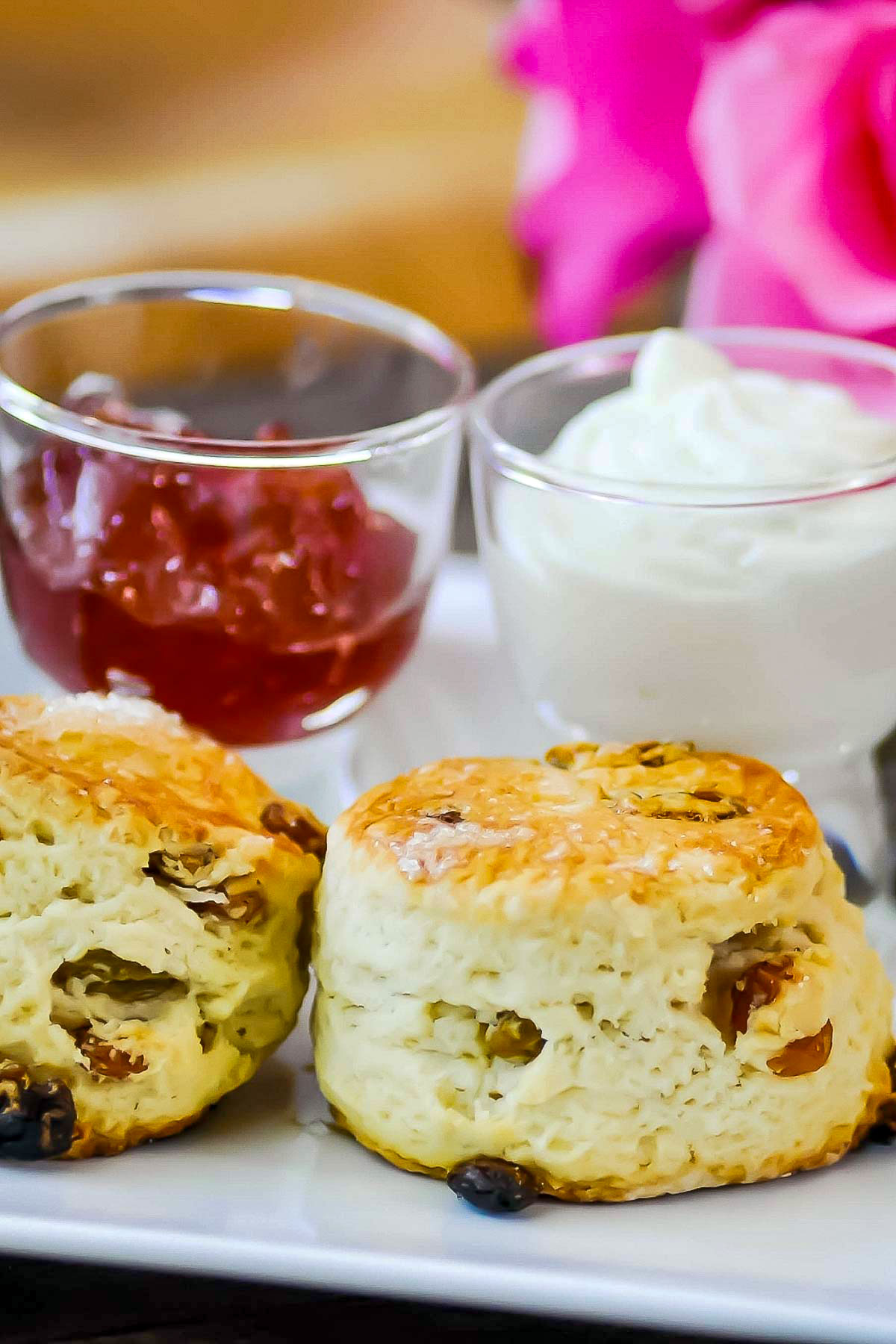
This recipe is part of my growing collection of sweet breads, muffins, and scones, where I am sure you can find some other recipes to try. Some of my favorites are Bishop's Bread, Banana Nut Muffins, or these Black Pepper And Ham Scones.
Jump to:
What is a scone
Some people are surprised to learn what a scone is, just as there are many things I'm unfamiliar with, too. A scone, originating from 16th-century Scotland, is a baked good that can be either sweet or savory. Initially made from oats, today's scones are commonly prepared with flour, baking powder, and butter, with milk, buttermilk, or cream added for moisture, and sometimes an egg for richness.
The term varies by region, known as "Scon" in Scotland and Ireland and "Scone" elsewhere, including the US and the UK. Traditionally served hot for breakfast or tea, scones in the UK are often accompanied by clotted cream and jam, differing from American biscuits in ingredients and sometimes shape, with British scones typically round and American versions often triangular.
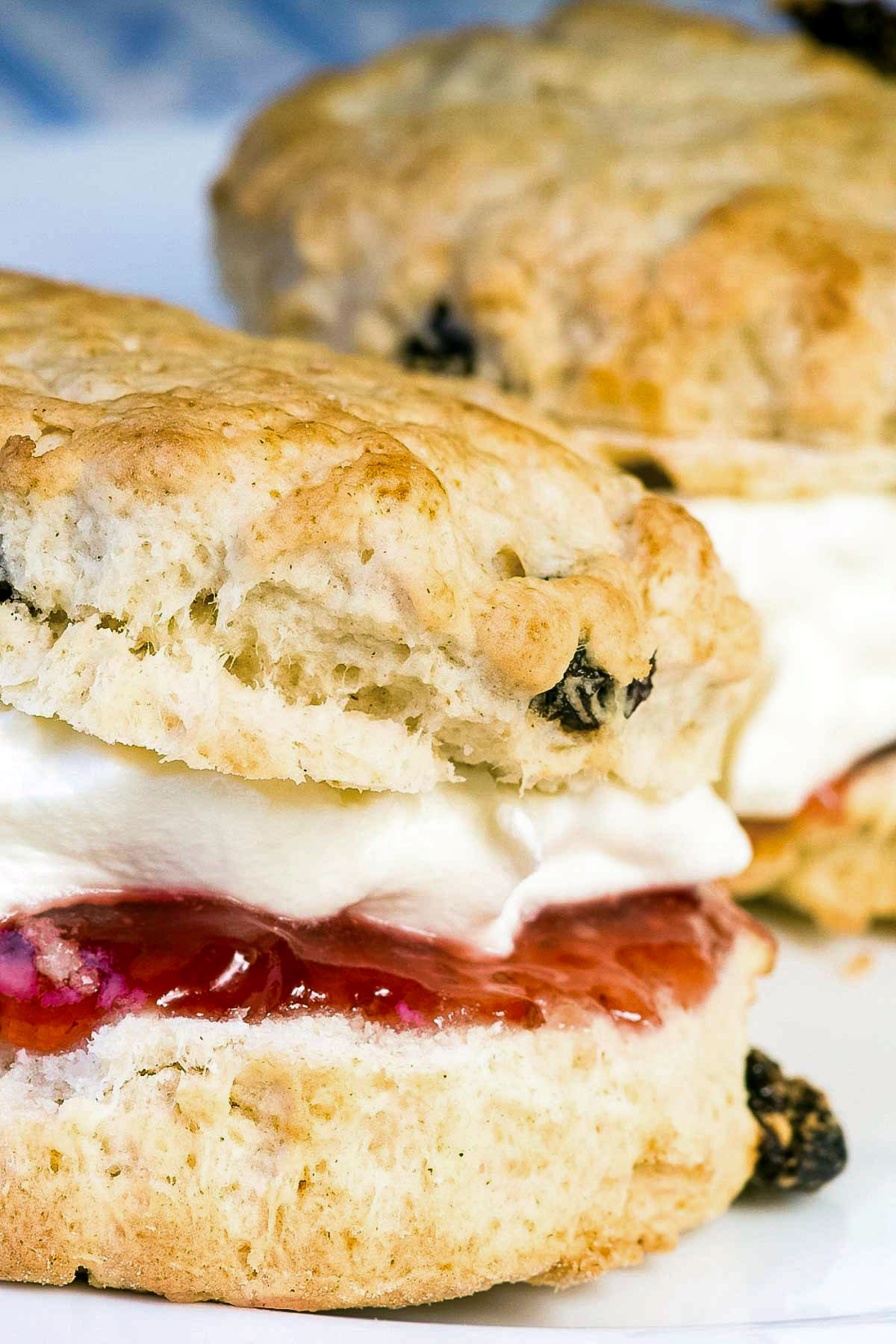
American scones are always enriched with a variety of ingredients like fruits, chocolate chips, nuts, zest, and spices, diverging from the British tradition, which typically features simpler scones, sometimes with raisins or currants.
A quality British scone is prized for being light and well-risen. Additionally, scones made with buttermilk tend to rise more than those made with milk or heavy cream.
Ingredients needed
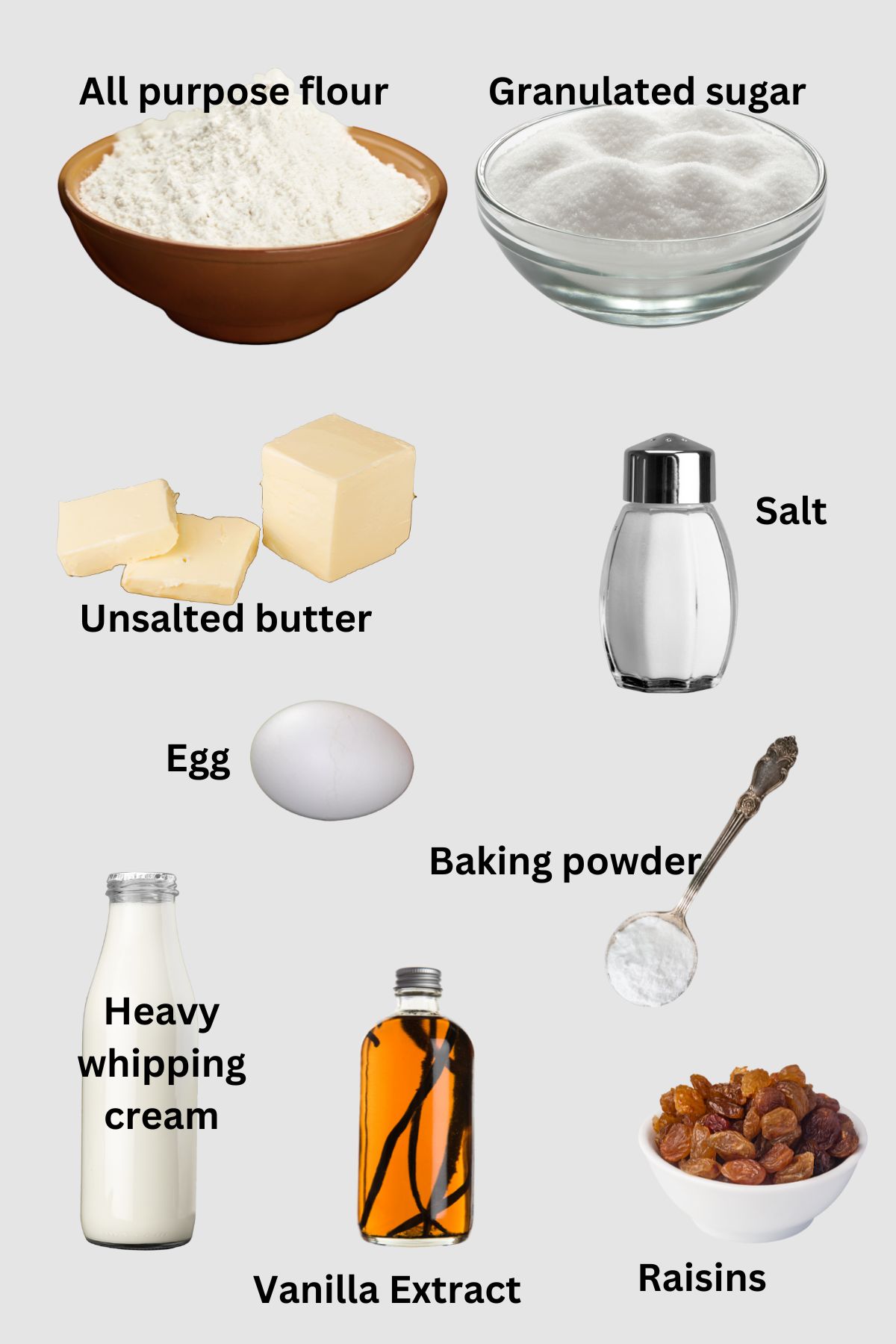
- Butter softened (for brushing the baking sheet) OR just parchment paper to cover the baking sheet
- All purpose flour
- Granulated sugar
- Baking powder
- Salt
- Cold unsalted butter
- Heavy whipping cream
- Large egg
- Vanilla extract
- Optional: Raisins/cranberries, orange zest from one orange, OR white or dark chocolate chips
Variations and substitutions
Savory Scones:
- Citrus and Herb: Incorporate 1 tablespoon of orange or lemon zest and 2 tablespoons of finely chopped herbs (like rosemary or thyme) for a fresh, aromatic flavor.
- Cheese and Herbs: Add one cup of grated cheese (such as sharp cheddar or Gruyère) and two tablespoons of your choice of fresh herbs to the dough after combining wet and dry ingredients.
- Maple Bacon: Blend in ½ cup of cooked, crumbled bacon and 2 tablespoons of maple syrup for a deliciously sweet and savory mix. Adjust the dough with a little extra flour if needed.
Sweet Scones:
- Dried Fruits: Mix in up to one cup of dried fruits like blueberries or cherries after combining the wet and dry ingredients but before the dough is fully moistened for a sweet, chewy texture.
- Chocolate Chips: Stir in up to one cup of chocolate chips under the same conditions as dried fruits for those who love a rich, chocolatey treat.
- Crunchy Sugar Topping: For a sweet crunch, sprinkle turbinado sugar over each scone after brushing with egg wash.
- Spiced Scones: Add one teaspoon of spices such as cinnamon, nutmeg, or cardamom to the flour mixture for a warm, comforting flavor.
- Earl Grey Infusion: For tea lovers, add the finely ground leaves from two bags of Earl Grey tea into the flour mixture for a subtle, fragrant twist.
How to make this scone recipe
Step 1. Preheat the oven. This is a rule that needs to be followed any time you need to bake something. Baked goods that contain buttermilk and baking soda or baking powder need to go inside a heated oven as soon as the dough is prepared.
Step 2. Mix the dry ingredients. In a large chilled mixing bowl, sift the flour and baking powder. Add the sugar and salt, orange, lemon zest, or both.
Add the butter bits, and using your fingers, rub the flour mixture and butter together until they look like flakes of course meal. (You can also do this step in a food processor)
If you want to add chocolate chips or dried fruits, this is the moment to toss them in the flour mixture.
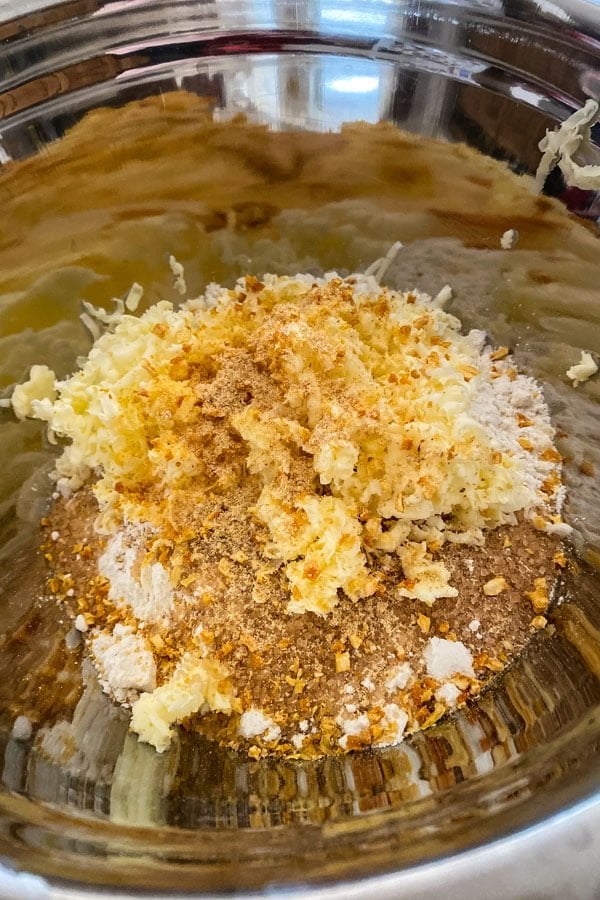
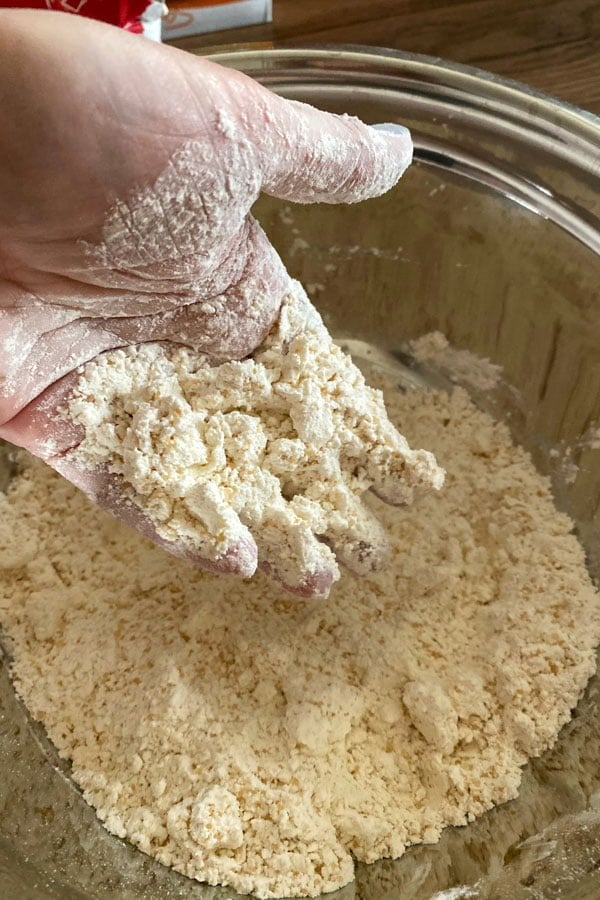
Step 3. Add the wet ingredients and form the dough. Use a whisk to beat the egg separately in a small bowl. Add the heavy whipping cream and the vanilla extract.
Pour the liquid over the flour mixture. With your hands, toss together until the dough can be gathered into a compact ball. Do not knead. Lightly flour a surface and roll the dough out about 1- inch thick circle.

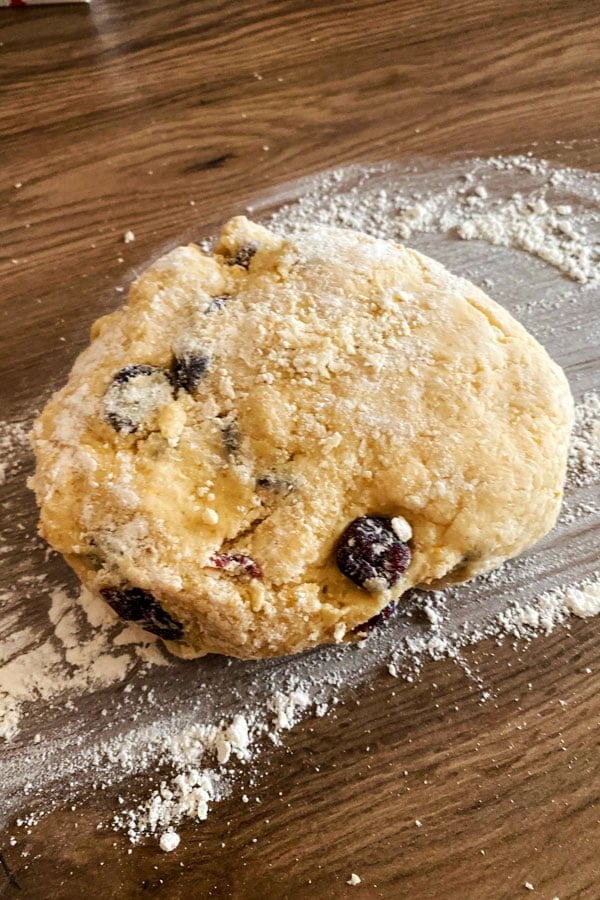
Use a cookie cutter or the rim of a glass to cut the dough into 2-inch rounds. Reroll and cut the scraps into similar rounds. Place the rounds about 1 inch apart on the baking sheet. Use a brush to glaze them with a little heavy cream or milk. Bake for about 15 minutes or until lightly brown.
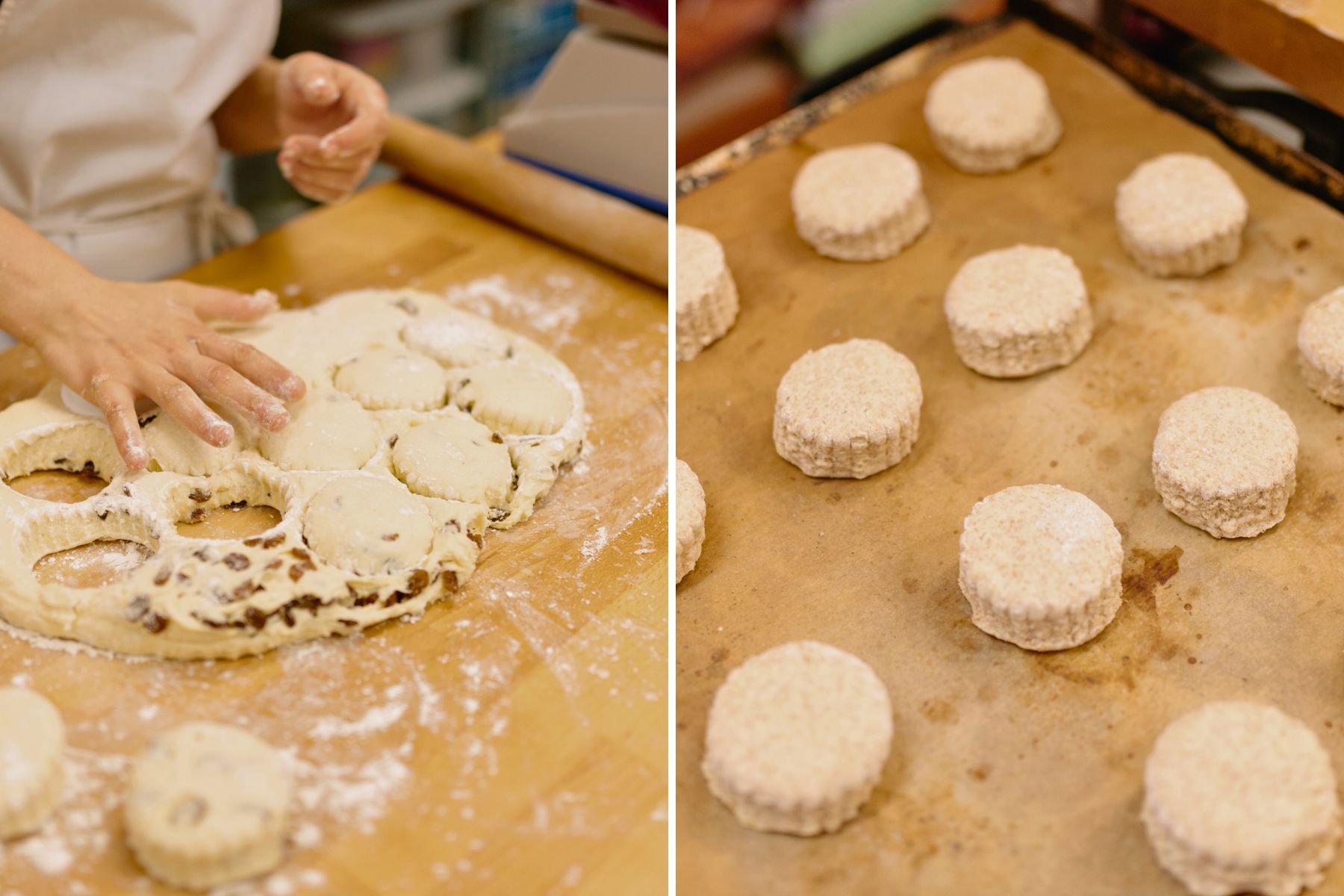
Serve it with Devonshire Cream (if you have any available) and your favorite jam. Butter is good as well, especially the Irish butter that you can find in almost any grocery store in the US.

How to store these British scones
One of the nicest things you can serve to a visitor is a freshly baked scone, but the reality is we do not always have the time to whip something up on the day we want to serve them. For this reason, I gathered some great tips for serving scones whenever you need to.
Freezing Scone Dough:
- Cut dough into shapes and place on a parchment-lined tray.
- Freeze for an hour, then transfer to a Ziploc bag.
- Store for up to three months; label with the date.
Storing Baked Scones:
- Wrap and freeze if not eaten the same day; good for a month.
- To serve, thaw at room temperature in wrapping, then reheat for five minutes at 350F unwrapped.
Room Temperature Storage:
- Ideal for short-term storage (a day or two).
- Use an airtight container or wrap to prevent drying.
Refrigeration:
- For storage up to about a week.
- Place in an airtight container; note that the texture may become firmer.
- Warm briefly in the oven or toaster oven before serving to refresh.

For your next homemade baking projects, I also suggest these Apricot And Sour Cream Scones, Cranberry Orange Banana Bread, and Classic Blueberry Muffins.
Answering Your Questions About English Scones
American scones are often sweeter, larger, and richer, typically loaded with fruits, nuts, or chocolate chips. They have a moist, cake-like texture.
English scones are smaller, less sweet, and designed to be split open and served with clotted cream and jam. They have a lighter, more biscuit-like texture.
Yes, scones can be made ahead in two ways: you can prepare and freeze the unbaked scone dough or bake the scones and freeze them once cooled.
Frozen unbaked scones can be baked straight from the freezer, adding a few extra minutes to the baking time, while baked scones can be thawed and reheated, offering flexibility and convenience.
My last word on scones is always to use quality ingredients when you bake. Serve them with jam and clotted cream, like the Devonshire Cream that you can find in specialized stores. Or just serve them with a cup of coffee or tea as they are. Enjoy!
📖 Recipe
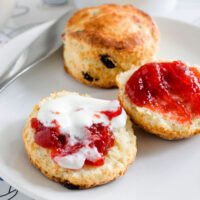
English Scones
Ingredients
- 1 tablespoon butter softened(for brushing the baking sheet) OR just parchment paper to cover the baking sheet
- 2 cups all-purpose flour
- ⅓ cup granulated sugar or 4 tablespoons
- 2 teaspoons baking powder
- ¼ teaspoon salt
- 4 tablespoons cold unsalted butter cut into ¼inch bits
- ½ cup heavy whipping cream
- 1 large egg
- 1 ½ teaspoon vanilla extract
- ¼ cup white or dark chocolate chips OR ¼ cup raisins/cranberries, orange zest from one orange
- 1 tablespoon heavy cream or milk for glazing the scones on top
Instructions
- Preheat the oven to 400F.
- Using a pastry brush, coat a large baking sheet with the softened butter and set it aside, or cover the baking sheet with parchment paper.
- In a large chilled mixing bowl, sift the flour and baking powder. Add the sugar and salt.
- Add the butter bits and using your fingers, rub the flour mixture and butter together until they look like flakes of course meal.
- If you want to add chocolate chips or dried fruits, this is the moment to toss them in the flour mixture.
- Use a whisk to beat the egg separately in a small bowl. Add the heavy whipping cream and the vanilla extract.
- Pour the liquid over the flour mixture. With your hands, toss together until the dough can be gathered into a compact ball. Do not knead.
- Lightly flour a surface and roll the dough out about a 1-inch thick circle.
- Use a cookie cutter or the rim of a glass, cut the dough into 2-inch rounds.
- Reroll and cut the scraps into similar rounds. Place the rounds about 1 inch apart on the baking sheet.
- Bake for about 15 minutes or until lightly brown.
- Serve it with Devonshire Cream and your favorite jam.
Notes
- Mix dough by hand: The secret of making good scones is a quick, light hand when mixing and a hot oven. However, if you are in a hurry, you can use a food processor, at least for mixing the flour with the butter.
- Re-rolling the scraps: Gather up the bits of dough and press them gently together, as over-handling will lead to tough scones.
- Shape: Making the scones in a triangular shape, like a wedge, will avoid handling the dough too much.
- Cold butter: working with cold butter rather than room temperature will give you a nice flakier texture to your final scones.
- Amount of liquid: Always hold back on some of the liquid to allow you to judge when you've added enough. Ingredients, like flour, behave differently depending on many variables, and it is much easier to add more liquid than to try to rebalance with extra flour. You aim for a dough that holds together without crumbling, but that isn't overly sticky to handle.
- Glaze the scones: A little beaten egg, milk, or heavy cream left over are great for glazing the scones before baking. You can mix it with some milk to make it go further.
- Preheating the baking tray and baking in a fully preheated oven will help give your scones a nice crust and a good rise.



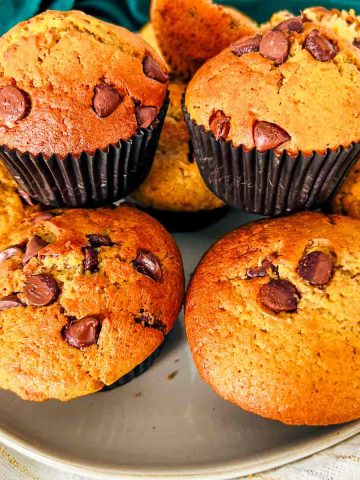
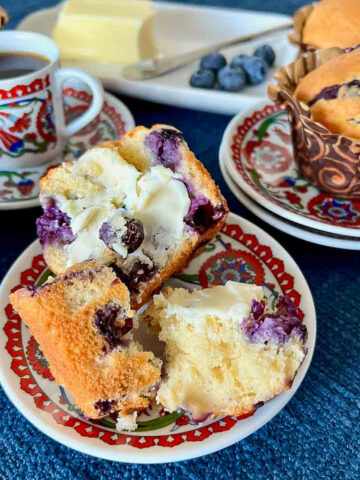




Ryan says
These did not raise at all. Flat as pancakes. New baking powder, I kept the butter cold, cold bowl, I am really at a loss. Any ideas as to why they didn't work?
Gabriela says
Hi, I’m sorry the scones didn’t turn out as you expected. Were you able to fully preheat your oven before baking? How did you measure the flour? (Spoon-and-level method, scooping the cup directly, etc.) Did you make any ingredient substitutions or changes to the recipe?
How thick did you roll the dough?
Did you press straight down with the cutter or twist it? These are the reasons, in general, why a scone would not rise.